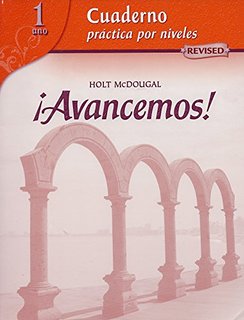
All Solutions
Page 350: Gramatica A
All the sentences are in the present progressive, so you should know how to conjugate *estar (to be)* and which endings to add to the present participle.
**estar (to be) + present participle = present progressive**
|Singular |Plural |
|–|–|
|Yo **estoy** |Nosotros **estamos** |
|Tú **estás** |Ustedes **están** |
|Él/Ella/Usted **está** | Ellos/Ellas **están**|
– ***-ar*** verbs have the ending ***-ando*** (e.g. camin*ando*)
– ***-er*** and ***-ir*** verbs have the ending ***- iendo*** (e.g. com*iendo*)
Los hermanos de Lorenzo — están sacando…
*(Lorenzo’s siblings — are getting the suitcases.)*
*Lorenzo’s siblings (they)* is third-person plural, so we used the third-person plural form of *estar,* which is *”están.”*
Lorenzo — está efeitandose.
*(Lorenzo — is shaving.)*
*Lorenzo (he)* is third-person singular, so we used the third-person singular form of *estar,* which is *”está.”*
La madre de Lorenzo y yo — estamos hablando del hotel.
*(Lorenzo’s mother and I — are talking about the hotel.)*
*Lorenzo’s mother (we)* is first-person plural, so we used the first-person plural form of *estar,* which is *”estamos.”*
Tú — estás pidiendo la comida.
(*You — are ordering food.)*
*Tú (you)* is second-person singular, so we used the second-person singular form of *estar,* which is *”estás.”*
1. C
2. A
3. B
4. D
**estar (to be) + present participle = present progressive**
Here is some useful information to help you master the **present participle**:
– ***-ar*** verbs have the ending ***-ando*** (e.g. camin*ando*)
– ***-er*** and ***-ir*** verbs have the ending ***- iendo*** (e.g. com*iendo*)
|Singular |Plural |
|–|–|
|Yo **estoy** |Nosotros **estamos** |
|Tú **estás** |Ustedes **están** |
|Él/Ella/Usted **está** | Ellos/Ellas **están**|
*(Javier is talking on the phone.)*
*Javier (he)* is third-person singular, so we used the third-person singular form of *estar,* which is *”está.”*
*Hablar (to talk)* ends with *-ar*, so we added *-ando* ending.
*(Nora and Carla are walking in the woods.)*
*Nora and Carla (they)* is third-person plural, so we used the third-person plural form of *estar,* which is *”están.”*
*Caminar (to walk)* ends with *-ar*, so we added *-ando* ending.
*(I am packing the suuitcases.)*
*Yo (I)* is first-person singular, so we used the first-person singular form of *estar,* which is *”estoy.”*
*Hacer (to do)* ends with *-er*, so we added *-iendo* ending.
*(Are you getting dressed?)*
*Usted (you)* is a formal second-person singular, which is conjugated the same as the third-person singular, so we used the third-person singular form of *estar,* which is *”está.”*
Note that *vestir**se*** is a reflexive verb, so we used a pronoun appropriate for the third-person singular, which is ***”se.”***
*Vestir (to dress)* ends with *-ir*, so we added *-iendo* ending. The stem also changed from *e* to *i*.
*(Guys, are you sleeping?)*
*Ustedes (you)* is second-person plural, which is conjugated the same as the third-person plural, so we used the third-person plural form of *estar,* which is *”están.”*
*Dormir (to sleep)* ends with *-ir*, so we added *-iendo* ending. The stem also changed from *o* to *u*.
1. está hablando
2. están caminando
3. estoy haciendo
4. se está vistiendo
5. están durmiendo
You should write what you see people on the drawings are doing. The first sentence has been done already.
There are more ways to say what the people are doing, so use the answers below as a reference.
*(The tourists are taking photos.)*
*The tourists (they)* is third-person plural, so we used the third-person plural form of *estar (to be)*, which is *”están.”*
*Tomar (to take)* ends with *-ar*, so we added the *-ando* ending.
*(Silvia is using the computer.)*
*Silvia (she)* is third-person singular, so we used the third-person singular form of *estar (to be)*, which is *”está.”*
*Usar (to use)* ends *-ar*, so we added the *-ando* ending.

